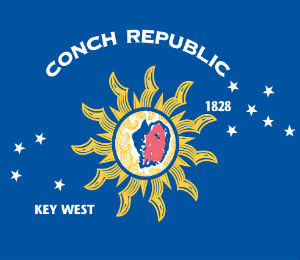Before delving into the fascinating answer to the question “What is the Conch Republic,” it is paramount that the correct pronunciation of the word “conch” is established since this is somewhat of a bone of contention among many people, especially Key West, Florida residents. Consulting any dictionary will reveal that in the preferred pronunciation the final sound 'ch' is pronounced as a hard K (konk) as opposed to the softer 'ch' as in the word church.
While the role that the “Conch Republic” played in the history of Key West circa 1840 is extremely interesting, many people are flabbergasted to learn that the “Conch Republic”contributed a new chapter to the history of Key West as late as 1982. In an effort to stem the tide of illegal drug traffic into the United States, on April 23, 1982 the U.S. Border Patrol staged a blockade of U.S. Highway 1. This action prevented Key West travel to the mainland since this route serves as the only connector from Key West to the rest of Florida and to the USA mainland. A federal court injunction was quickly filed by Key West's mayor indicating that if the blockade continued, Key West would secede from the United States of America and become “The Conch Republic.”
Each year, since the middle 1990s, the annual Conch Republic celebration is held beginning on the 23rd of April and continuing for a week. Key West travel brochures highlight this event including information about the creation of The Conch Republic National Anthem in 1994 that was first played by the Key Lime Pie band. Definitely not to be missed is the moment when the current mayor of Key West crumbles a stale loaf of Cuban bread over the head of the current U.S. Navy base commander in remembrance of when official secession of Key West from the contiguous 48 states was anticipated to occur.
The name of the USA's southernmost city, Key West, is derived from the Spanish phrase Cayo Hueso that translates to bone cay/key. According to historical accounts, this area was first explored by Ponce de Leon who claimed to have found human bones strewn everywhere. Originally controlled by Great Britain beginning in 1763, the area encompassing Key West was ultimately occupied in 1822 by United States Naval forces under the command of Admiral Matthew C. Perry.
Around 1830, an influx of new inhabitants, Bahamian fishermen, were attracted to Key West often referred to as the “Gibraltar of the West” because of its location on the 90-mile Strait of Florida that connects the Atlantic Ocean with the Gulf of Mexico. These new individuals were affectionately known as conch or conchys. Today, Key West natives are affectionately referred to as 'conch' to distinguish them from transplants or 'freshwater conch.'
In 1949, conch once again played a role in the history of Key West with the discovery of an abundance of shrimp and conch in the Tortugas and Marquesas areas of Key West. This 'Pink Gold' resulted in a thriving, lucrative endeavor for fishermen who cast trawling nets into the water.

